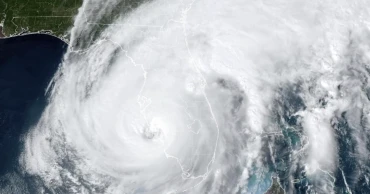Hurricane Ian
Ian leaves 47 dead in Florida; focus turns to rescue, recovery
Rescuers evacuated stunned survivors on a large barrier island cut off by Hurricane Ian and Florida's death toll climbed sharply, as hundreds of thousands of people were still sweltering without power days after the monster storm rampaged from the state's southwestern coast up to the Carolinas.
Florida, with nearly four dozen reported dead, was hit hardest by the Category 4 hurricane, one of the strongest to make landfall in the United States. Flooded roadways and washed-out bridges to barrier islands left many people isolated, amid limited cellphone service and a lack of basic amenities such as water, electricity and the internet.
Florida Gov. Ron DeSantis said Saturday that multibillionaire businessman Elon Musk was providing some 120 Starlink satellites to “help bridge some of the communication issues.” Starlink, a satellite-based internet system created by Musk's SpaceX, will provide high-speed connectivity.
Florida utilities were working to restore power. As of Saturday night, nearly 1 million homes and businesses were still without electricity, down from a peak of 2.67 million.
At least 54 people were confirmed dead: 47 in Florida, four in North Carolina and three in Cuba.
More than 1,000 people were rescued from flooded areas along Florida's southwestern coast alone, Daniel Hokanson, a four-star general and head of the National Guard, told The Associated Press while airborne to Florida.
In Washington, the White House announced that President Joe Biden and first lady Jill Biden would travel to Florida on Wednesday. But a brief statement did not release any details of the planned visit to the state.
The bridge to Pine Island, the largest barrier island off Florida’s Gulf Coast, was destroyed by the storm, leaving it accessible only by boat or air. The volunteer group Medic Corps, which responds to natural disasters worldwide with pilots, paramedics and doctors, went door-to-door asking residents if they wanted to be evacuated.
Some flew out by helicopter, and people described the horror of being trapped in their homes as water kept rising.
“The water just kept pounding the house and we watched, boats, houses — we watched everything just go flying by,” Joe Conforti said, fighting back tears. He said if it wasn’t for his wife, who suggested they get up on a table to avoid the rising water, he wouldn’t have made it: “I started to lose sensibility, because when the water’s at your door and it’s splashing on the door and you’re seeing how fast it’s moving, there’s no way you’re going to survive that.”
River flooding posed a major challenge at times to rescue and supply delivery efforts. The Myakka River washed over a stretch of Interstate 75, forcing a traffic-snarling highway closure for a while before officials said later Saturday that it could be reopened.
While swollen rivers have crested or are near cresting, the levels aren’t expected to drop significantly for days, National Weather Service meteorologist Tyler Fleming said.
Elsewhere, South Carolina's Pawleys Island, a beach community roughly 75 miles (115 kilometers) up the coast from Charleston, was also hit hard. Power remained knocked out to at least half the island Saturday.
Eddie Wilder, who has been coming to Pawleys Island for more than six decades, said it was “insane” to see waves as high as 25 feet (7.6 meters) wash away a landmark pier near his home.
“We watched it hit the pier and saw the pier disappear,” he said. “We watched it crumble and and watched it float by with an American flag.”
Wilder's house, located 30 feet (9 meters) above the shoreline, stayed dry inside.
In North Carolina, the storm downed trees and power lines. Two of the four deaths in the state were from storm-related vehicle crashes, and the others involved a man who drowned when his truck plunged into a swamp and another killed by carbon monoxide poisoning from a generator in a garage.
At Port Sanibel Marina in Fort Myers, Florida, the storm surge pushed several boats and a dock onshore. Charter captain Ryan Kane said his vessel was so badly damaged that he was unable to use it to help rescue people, and now it will be a long time before he can take clients fishing again.
“There’s a hole in the hull. It took water in the motors. It took water in everything,” he said, adding: “You know, boats are supposed to be in the water, not in parking lots."
3 years ago
Hurricane Ian: Florida’s death toll climbs to 27
A revived Hurricane Ian pounded coastal South Carolina on Friday, ripping apart piers and flooding streets after the ferocious storm caused catastrophic damage in Florida, trapping thousands in their homes and leaving at least 27 people dead.
The powerful storm, estimated to be one of the costliest hurricanes ever to hit the U.S., has terrorized people for much of the week — pummeling western Cuba and raking across Florida before gathering strength in the warm waters of the Atlantic Ocean to curve back and strike South Carolina.
While Ian’s center came ashore near Georgetown, South Carolina, on Friday with much weaker winds than when it crossed Florida’s Gulf Coast earlier in the week, the storm left many areas of Charleston’s downtown peninsula under water. It also washed away parts of four piers along the coast, including two at Myrtle Beach.
Online cameras showed seawater filling neighborhoods in Garden City to calf level. As Ian moved across South Carolina on its way to North Carolina Friday evening, it dropped from a hurricane to a post-tropical cyclone.
Ian left a broad swath of destruction in Florida, flooding areas on both of its coasts, tearing homes from their slabs, demolishing beachfront businesses and leaving more than 2 million people without power.
Many of the deaths were drownings, including that of a 68-year-old woman swept away into the ocean by a wave. A 67-year-old man who was waiting to be rescued died after falling into rising water inside his home, authorities said.
Other storm-related fatalities included a 22-year-old woman who died after an ATV rollover from a road washout and a 71-year-old man who fell off a roof while putting up rain shutters. An 80-year-old woman and a 94-year-old man who relied on oxygen machines also died after the equipment stopped working during power outages.
Another three people died in Cuba earlier in the week as the storm churned northward. The death toll was expected to increase substantially once emergency officials have an opportunity to search many of the hardest-hit areas.
Rescue crews piloted boats and waded through riverine streets in Florida after the storm to save thousands of people trapped amid flooded homes and shattered buildings .
Florida Gov. Ron DeSantis said Friday that crews had gone door-to-door to over 3,000 homes in the hardest-hit areas.
“There’s really been a Herculean effort,” he said during a news conference in Tallahassee.
Also read: Ian floods southwest Florida, engulfing residents in houses
Hurricane Ian has likely caused “well over $100 billion” in damage, including $63 billion in privately insured losses, according to the disaster modeling firm Karen Clark & Company, which regularly issues flash catastrophe estimates. If those numbers are borne out, that would make Ian at least the fourth costliest hurricane in U.S. history.
Florida Division of Emergency Management Director Kevin Guthrie said first responders have focused so far on “hasty” searches, aimed at emergency rescues and initial assessments, which will be followed by two additional waves of searches. Initial responders who come across possible remains are leaving them without confirming, he said Friday, describing as an example the case of a submerged home.
“The water was up over the rooftop, right, but we had a Coast Guard rescue swimmer swim down into it and he could identify that it appeared to be human remains. We do not know exactly how many,” Guthrie said.
Desperate to locate and rescue their loved ones, social media users shared phone numbers, addresses and photos of their family members and friends online for anyone who can check on them.
Orlando residents returned to flooded homes Friday, rolling up their pants to wade through muddy, knee-high water in their streets. Friends of Ramon Rodriguez dropped off ice, bottled water and hot coffee at the entrance to his subdivision, where 10 of the 50 homes were flooded and the road looked like a lake. He had no power or food at his house, and his car was trapped by the water.
“There’s water everywhere,” Rodriguez said. “The situation here is pretty bad.”
The devastating storm surge destroyed many older homes on the barrier island of Sanibel, Florida, and gouged crevices into its sand dunes. Taller condominium buildings were intact but with the bottom floor blown out. Trees and utility poles were strewn everywhere.
Municipal rescuers, private teams and the Coast Guard used boats and helicopters Friday to evacuate residents who stayed for the storm and then were cut off from the mainland when a causeway collapsed. Volunteers who went to the island on personal watercraft helped escort an elderly couple to an area where Coast Guard rescuers took them aboard a helicopter.
Hours after weakening to a tropical storm while crossing the Florida peninsula, Ian regained strength Thursday evening over the Atlantic. Ian made landfall in South Carolina with maximum sustained winds of 85 mph (140 kph). When it hit Florida’s Gulf Coast on Wednesday, it was a powerful Category 4 hurricane with 150 mph (240 kph).
After the heaviest of the rainfall blew through Charleston, Will Shalosky examined a large elm tree in front of his house that had fallen across his downtown street. He noted the damage could have been much worse.
“If this tree has fallen a different way, it would be in our house,” Shalosky said. “It’s pretty scary, pretty jarring.”
Ian’s heavy rains and winds crossed into North Carolina on Friday evening. Gov. Roy Cooper warned residents to be vigilant, given that up to 8 inches (20.3 centimeters) of rain could fall in some areas.
“Hurricane Ian is at our door. Expect drenching rain and sustained heavy winds over most of our state,” Cooper said. “Our message today is simple: Be smart and be safe.”
In Washington, President Joe Biden said he was directing “every possible action be taken to save lives and get help to survivors.”
“It’s going to take months, years to rebuild,” Biden said.
“I just want the people of Florida to know, we see what you’re going through and we’re with you.”
3 years ago
Ian floods southwest Florida, engulfing residents in houses
Hurricane Ian, one of the most powerful storms ever recorded in the U.S., swamped southwest Florida on Wednesday, turning streets into rivers, knocking out power to 1.8 million people and threatening catastrophic damage further inland.
A coastal sheriff’s office reported that it was getting many calls from people trapped in flooded homes. Desperate people posted to Facebook and other social sites, pleading for rescue for themselves or loved ones. Some video showed debris-covered water sloshing toward homes’ eaves.
The hurricane’s center made landfall near Cayo Costa, a barrier island just west of heavily populated Fort Myers. As it approached, water drained from Tampa Bay.
Mark Pritchett stepped outside his home in Venice around the time the hurricane churned ashore from the Gulf of Mexico, about 35 miles (55 kilometers) to the south. He called it “terrifying.”
“I literally couldn’t stand against the wind,” Pritchett wrote in a text message. “Rain shooting like needles. My street is a river. Limbs and trees down. And the worst is yet to come.”
The Category 4 storm slammed the coast with 150 mph (241 kph) winds and pushed a wall of storm surge accumulated during its slow march over the Gulf. More than 1.8 million Florida homes and businesses were without electricity, according to PowerOutage.us. Nearly every home and business in three counties was without power.
The storm previously tore into Cuba, killing two people and bringing down the country’s electrical grid.
About 2.5 million people were ordered to evacuate southwest Florida before Ian hit, but by law no one could be forced to flee.
News anchors at Fort Myers television station WINK had to abandon their usual desk and continue storm coverage from another location in their newsroom because water was pushing into their building near the Caloosahatchee River.
Though expected to weaken to a tropical storm as it marches inland at about 9 mph (14 kph), Ian’s hurricane force winds were likely to be felt well into central Florida. Hours after landfall, top sustained winds had dropped to 105 mph (170 kph), making it a Category 2 hurricane. Still, storm surges as high as 6 feet (2 meters) were expected on the opposite side of the state, in northeast Florida.
Sheriff Bull Prummell of Charlotte County, just north of Fort Myers, announced a curfew between 9 p.m. and 6 a.m. “for life-saving purposes,” saying violators may face second-degree misdemeanor charges.
“I am enacting this curfew as a means of protecting the people and property of Charlotte County Prummell said.
Jackson Boone left his home near the Gulf coast and hunkered down at his law office in Venice with employees and their pets. Boone at one point opened a door to howling wind and rain flying sideways.
“We’re seeing tree damage, horizontal rain, very high wind,” Boone said by phone. “We have a 50-plus-year-old oak tree that has toppled over.”
In Naples, the first floor of a fire station was inundated with about 3 feet (1 meter) of water and firefighters worked to salvage gear from a firetruck stuck outside the garage in even deeper water, a video posted by the Naples Fire Department showed. Naples is in Collier County, where the sheriff’s department reported on Facebook that it was getting “a significant number of calls of people trapped by water in their homes” and that it would prioritize reaching people “reporting life threatening medical emergencies in deep water.”
Ian’s strength at landfall tied it for the fifth-strongest hurricane when measured by wind speed to strike the U.S. Among the other storms was Hurricane Charley, which hit nearly the same spot on Florida’s coast in August 2004, killing 10 people and inflicting $14 billion in damage.
Ian made landfall more than 100 miles (160 kilometers) south of Tampa and St. Petersburg, sparing the densely populated Tampa Bay area from its first direct hit by a major hurricane since 1921.
Flash floods were possible all across Florida. Hazards include the polluted leftovers of Florida’s phosphate fertilizer mining industry, more than 1 billion tons of slightly radioactive waste contained in enormous ponds that could overflow in heavy rains.
The federal government sent 300 ambulances with medical teams and was ready to truck in 3.7 million meals and 3.5 million liters of water once the storm passes.
“We’ll be there to help you clean up and rebuild, to help Florida get moving again,” President Joe Biden said Wednesday. “And we’ll be there every step of the way. That’s my absolute commitment to the people of the state of Florida.”
Florida Gov. Ron DeSantis has requested Biden grant a Major Disaster Declaration for all 67 of the state’s counties, which would open a range of federal assistance for residents and funding for public infrastructure repairs. DeSantis has also asked Biden to allow FEMA to provide a 100% federal cost share for debris removal and emergency protective measures for 60 days.
The governors of Virginia, Georgia, South Carolina and North Carolina all preemptively declared states of emergency. Forecasters predicted Ian will turn toward those states as a tropical storm, likely dumping more flooding rains into the weekend, after crossing Florida.
3 years ago





